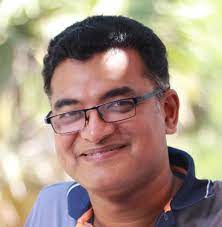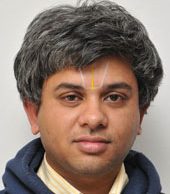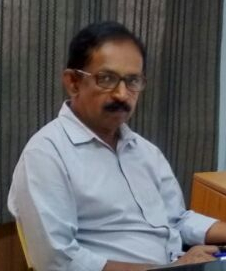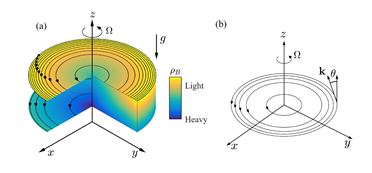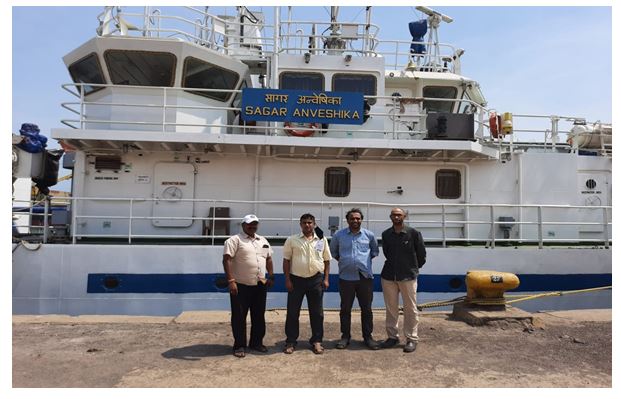Project
Basic understanding and predictions of events of destructive heavy rainfall over India during monsoon, on sub-seasonal (a week to a few weeks) time scales remain scientifically challenging (Webster et al. 1998, Lau et al. 2012). Active efforts are ongoing to develop a dynamical framework to improve monsoon prediction (Rao et al. 2019), under the Indian National Monsoon Mission. On a large scale, ocean dynamics and mixing are known to have a profound influence on monsoon activity. For example, shallow ocean mixed layers with weak winds in the Bay of Bengal (BoB) and deep mixed layers with strong winds in the western Arabian sea have contrasting effects of keeping the sea surface warm and cool, respectively; as a result, monsoon convection gets primarily locked to the BoB (Shenoi et al. 2002). Smaller scales are, however, critical to understand sub-seasonal dynamics. While the multi-scale nature of monsoon features is well-acknowledged, and order 1-10 km scales in the BoB has been revealed recently (figure 1), the scales that actively influence air-sea interaction are not well-understood. A recent modeling study (Samanta et al. 2018, fig. 2 right) has shown that 100 km scale lateral gradients of mixed layer depth and sea surface temperature in the coastal BoB can have a significant impact on monsoon rain, including its genesis. Pertinent questions that require attention now are: (i) what processes contribute to the 10-100 km scale lateral gradients in the upper ocean, and (ii) to what extent do these scales modify air-sea fluxes and possibly the frequency/intensity of monsoon meso-scale convection?

Fig. 1: Left panel - Cartoon depicting various ocean processes and air-sea interactions that influence ocean state and climate (source: Petrola & Woods 2018). Right top panel - Satellite-based sea surface temperature (SST) map showing fine-scale structures in the Bay of Bengal (source: Sengupta et al. 2016). Right bottom panel: Laboratory modeling of a geophysical flow in a rotating tank (source: Illari et al. 2009).
Mooring observations, under OMNI (Venkatesan et al. 2013) and RAMA (McPhaden et al. 2009) programs (fig. 2 left), give hourly data of upper ocean characteristics, and surface meteorological parameters. They provide useful insights on mixed layer evolution (e.g. Parampil et al. 2010) and ocean response to cyclones (e.g. Chaudhuri et al. 2019). Ship-based observations are complementary to mooring observations. Recent field campaigns in the open ocean of BoB, under the Indian Ocean Mixing and Monsoon (OMM, 2014-2020) and the US Air-Sea Interactions in the Northern Indian Ocean (ASIRI) programs working in an informal collaboration (special issues by Mahadevan et al. 2016, Gordon et al. 2019, 2020), deployed new ship-based observations and autonomous platforms to study the bay from sub-meso (order 1-10 km scales) to basin scales. They revealed rich frontal features, sub-mesoscale variability, shallow mixed layer dynamics, and suppressed turbulence under stable salinity stratification (Special Issue of Mahadevan et al. 2016). Observational efforts are ongoing in the southern BoB (Vinayachandran et al. 2018) and Arabian sea (Centurioni et al. 2017) too.

Fig. 2:Mooring locations in the Indian Ocean (source: NIOT, personal communication).

Climataogical mixed layer depth (in metres), along with the estimated genesis locations of monsoon depressions (source: Samanta et al. 2018).
A major gap in monsoon research is the absence of mooring observations, and too few ship-based field campaigns, within 250-300 km of the coast, except for a few moorings in very shallow water close to land. In coastal regions, where tides, topography and boundary currents introduce dynamics quite different from the open ocean while remaining significant for air-sea interactions, satellite measurements have data gaps too. Argo floats (Roemmich et al. 2009), potentially useful for coastal regions, generally do not give salinity measurements in the upper few meters. Observational campaigns in the coastal regions, using state-of-the-art physical oceanography (Venkatesan et al. 2018), are therefore the need of the hour. India’s advanced field measurements capabilities (NIOT, INCOIS) are well-suited to carry out such campaigns.
Spatially extended observations of the coastal regions, however, remain a challenge. Satellite imaging is useful for large-scale applications (Sharma et al. 2016), but its spatial/temporal resolution/accuracy are insufficient for coastal monitoring. Furthermore, satellite datasets have major uncertainties in the monsoon season due to deep clouds/heavy rainfall. On the other hand, local measurements using coastal radars, or in-situ measurements have insufficient spatial coverage. Autonomous Unmanned Aerial Systems (UASs) offer a viable means to achieve larger spatial coverage along with desired fine spatial/temporal resolution, potentially an invaluable intermediary between satellite imaging and in-situ measurements. UASs also offer the possibility of resolving the atmospheric boundary layer (Villa et al. 2016), representing an alternative to weather balloons at least in the lower few km of the atmosphere.
While field measurements are vital in describing the oceanography, and air-sea interactions, an understanding of underlying physical mechanisms are essential too. Theoretical modeling, lab experiments and fine-scale numerical simulations, motivated by various conditions of the northern Indian Ocean, are invaluable in this pursuit. Fine-scale numerical simulations motivated by BoB conditions are just emerging, with frontal dynamics at various scales being investigated (Sarkar et al. 2016). Modeling (e.g. Thomas et al. 2008) and experimental (e.g. Mathur & Peacock 2009) studies, while exploring some relevant small-scale processes, don’t yet specifically target northern Indian Ocean regimes. Field and lab studies tend to be performed by independent groups conventionally, whereas the proposed centre will involve a close interplay between the two.
While significant recent progress has been achieved in physical oceanography, laboratory studies, and numerical ocean & atmospheric modeling, a synergistic approach combining the three is the need of the hour. In this centre, we propose to rigorously combine (i) new fine-scale field measurements, (ii) fine-scale laboratory (experimental/numerical/theoretical) modeling of upper ocean physical processes, and (iii) large-scale coupled ocean-atmosphere modeling, to improve our understanding of air-sea interactions in the northern Indian ocean, especially the poorly observed/understood coastal regions. Field measurements will motivate targeted fine-scale lab studies, which in turn will motivate specific experiments with large-scale climate models. The climate model experiments will then motivate field and lab studies, with the ultimate objective being improvement in climate modeling and prediction.
The use of unmanned aerial systems (UASs) in atmospheric and oceanographic application is novel, and has high potential to advance physical oceanography. Measurements from aerial platforms operating at an altitude of a km or two represent an invaluable intermediary between satellite imaging and in-situ measurements. With carefully designed sorties, they could provide composite maps of sea surface properties like SST over spatially extended regions while providing a spatial resolution of the order of a metre. Furthermore, the use of UASs for atmospheric boundary layer measurements represents a significant advantage over conventionally used weather balloons: controlled vertical profiles at desired locations are possible, and the payload is not lost with every launch. While there exists challenges in establishing effective use of UASs in harsh coastal environments & high altitudes, the team with experts in Aerospace Engg. and Image Processing is well placed to address them. Finally, our centre could lead towards disruptive technologies like deployment of ocean sensors from UASs.
Expected deliverables of the research
The underlying science objective of all the centre’s activities in the next five years would be to advance our understanding of the role of coastal processes, and 1-100 km spatial scales in both the coastal and open ocean regions, on air-sea interactions in the northern Indian ocean. The specific objectives are
- Establishment of a centre with a unified approach, combining field measurements, climate modeling and laboratory modeling (theory/simulations/experiments), towards geophysical flows (see figure below),

Targeted survey of the coastal regions of the northern Indian ocean (Bay of Bengal in the first phase, expanding towards Arabian sea in the second phase) using state-of-the-art physical oceanography methods to characterize upper ocean dynamics and mixing. The centre will work with the National Institute of Ocean Technology (NIOT) and Indian National Centre for Ocean Information Services (INCOIS) on field campaigns.
Design and development of autonomous unmanned aerial systems for atmospheric measurements and sea surface imaging. Two configurations will be developed: (i) Quad-rotors for vertical profiling with extended endurance, and (ii) Fixed-wing type aircraft for measurements over extended horizontal domains. In addition to flight in harsh environments, sensor integration and image processing will represent key challenges. This activity will open up tremendous possibilities for future oceanographic and meteorological observational campaigns worldwide.
Fine-scale process modeling in the lab , via experiments, simulations and theoretical modeling, of small-scale processes influencing the upper ocean structure in the northern Indian ocean. This would advance our understanding of various dynamic and thermodynamic processes influencing air-sea interactions in the northern Indian ocean, and thus the relative importance of accurately parameterizing them in climate models, This activity would be a natural continuation of ongoing research on rotating and stratified flows at IIT Madras.
Coupled ocean-atmosphere climate modeling (sensitivity experiments and data assimilation), based on inputs from field experiments and fine-scale process modeling, to progress towards a better understanding of predictive capabilities of climate models. The centre will work with National Centre for Medium Range Weather Forecasting (NCMRWF) for this activity.
Current status
The research activities of the research initiative are broadly on two different themes:
- Field measurements & Climate models, and
- Process studies. The main goal is for the two themes to complement each other to subsequently improve our understanding of the dynamically important processes and improve monsoon predictions.
The following projects in each of these themes have been identified and are ongoing.
FIELD MEASUREMENTS & CLIMATE MODELS
Unmanned Aerial Systems for Oceanography and Meteorology
Personnel - Bharath Govindarajan (co-PI), Joel George (co-PI), P.A. Ramakrishna (co-PI), H.S.N. Murthy (co-PI), M. Ramakrishna (co-PI), Manikandan Mathur (PI), Vivek Shah (Project Associate), Yash Dhaduk (Project Associate), Pavan N (PhD student), Ajith Joseph (PhD student), Bijay Balia Hembram (M. Tech. student)
A key focus of the pCOE’s activity is on the use of Unmanned Aerial Vehicle (UAVs) capable of capturing relevant oceanographic and atmospheric data, such as sea-surface temperature, atmospheric velocity and pressure profiles. These quantities have a significant impact on the development of geophysical flows in general — and within the context of Bay of Bengal, in the development of the southeast monsoon. UAVs, particularly those with vertical lift capability, have the potential to replace existing weather balloons in the lower few kilometers of the atmosphere owing to their reusability and their controllability in the presence of gusts. Weather balloons, operating at altitudes up to around 10 km, are widely used by airports, rocket launching stations, ocean and atmospheric observation systems, and climate research scientists. Owing to their wide usage, and given each weather balloon (along with its radiosonde payload) is permanently lost after every usage, the overall associated costs are very large. Furthermore, only minimal control is possible in terms of the spatial trajectory that a weather balloon takes, and hence significantly limits the extent to which the measurements are spatially and temporally resolved. To this end, the target at the end of Phase-1 is to establish quad-rotors and hex-rotors as the platform of choice with sufficient control and stability to operate in these gusty environments.
In the next few months, the quad/hexacopter platforms will be taken on a scientific cruise onboard a research vessel off the coast of either Chennai or Paradip (based on permissions) to make scientific measurements.
In addition, we have also started the design and development of a fixed-wing UAV with VTOL capability with good endurance for weather monitoring applications. The conceptual design is in progress now.
Observations of the dynamical ocean state on a continental slope in the north-west Bay of Bengal
Personnel - Manikandan Mathur (PI), Jithendra Raju Nadimpalli (Project Officer), J. Lijin (PhD student), N. Suresh Kumar, V.P. Thangaprakash, B. Praveen Kumar (the last three are scientists at INCOIS Hyderabad)
Satellite altimetry and numerical ocean modeling reveal strong internal tide activity in the northwest Bay of Bengal (BoB), the source of which is likely to be the continental shelf break region in its neighbourhood. This region is also dynamically unique owing to the large freshwater input from the riverine systems along the northern boundary of BoB. This work aims to report an integrated set of measurements in the shelf break region off Paradip and the analysis of them leading to modeling and conclusions about internal tide activity backed by high-resolution numerical experiments using a non-hydrostatic ocean model.
Role of three-dimensional processes in the Bay of Bengal
Personnel - Manikandan Mathur (PI), Debasis Sengupta (Indian Institute of Science), Amit Tandon (University of Massachusetts at Dartmouth, USA), Jennifer MacKinnon, Sutanu Sarkar, Andrew Lucas (University of California at San Diego, USA), Eric D’Asaro , Craig Lee (University of Washington at Seattle, USA), Jonathan Nash, Simon de Szoeke (Oregon State University, USA), Tom Farrar, Amala Mahadevan (Woodshole Oceanographic Institute, USA), Aneesh Subramanian (University of Colorado at Boulder, USA)
In this work, we seek to qualitatively and quantitatively identify the role of various three-dimensional and one-dimensional processes in setting the upper ocean state in the freshwater-dominated Bay of Bengal. The work represents a collaborative effort involving the aforementioned personnel, extensively analysing the large sets of measurements and datasets generated in the Ocean Mixing & Monsoon (OMM) program of India and the ASIRI & MISOBOB programs of the US.
Anomalous Sea Surface Temperature Over Southeastern Arabian Sea during Indian Ocean Dipole years
Personnel - Manikandan Mathur (PI), Simi Mathew (postdoc) The anomalous nature of the eastern and western regions of the equatorial Indian Ocean during Indian Ocean Dipole (IOD) years is well known and characterised by several previous studies. However, corresponding signatures of IOD in the northern Indian ocean is relatively less explored. In this work, we focus on the anomalous behaviour of sea surface temperature (SST) over southeastern Arabian Sea during IOD years.
Lagrangian analysis of advective transport and mixing in the northern Indian Ocean
Personnel - Manikandan Mathur (PI), J. Lijin (PhD student), Aditya Chaudhary (external PhD student employed at Space Applications Centre, ISRO), Jai Pundir, Neeraj Agarwal, Rashmi Sharma (the last three are scientists at Space Applications Centre, ISRO), Eric d’Asaro (University of Washington, Seattle, USA).
Advective transport by oceanic currents has significant implications for various processes like dispersal of pollutants (e.g. oil spill), transport of nutrients, chlorophyll etc., and the evolution of sea surface temperature (SST) and sea surface salinity (SSS). As a result, it has relevance for environmental applications (including prediction of dispersal of contaminants), providing invaluable information to fisheries and other ecological agencies, and climate modeling. The study is supported by an ISRO’s Space Technology Cell (STC) project, with a goal to provide input to specifications of future satellite payloads used for estimating ocean surface currents and sea surface imaging of various tracer quantities. The project deliverables are directly relevant for the ISRO programmes Samudra and OCEANSAT-3.
Seasonal variations in coastally generated near-inertial currents and associated mixing within an Arctic fjord
Personnel - Jithendra Raju Nadimpalli (Project Officer), Manikandan Mathur (PI)
Changes in wind stress can force near-inertial oscillations in the ocean surface layer, which subsequently induce upwelling and downwelling motions if occurring in coastal regions. Readjustment of upward and downward moving isopycnals can then excite offshore propagating coastal near-inertial waves (CNIWs). This study involves using hydrographic observations from IndARC mooring within the Arctic fjord, Kongsfjorden that show the presence of CNIWs during strong storm events. A combination of theoretical and high-resolution numerical modeling is to be performed to understand the aforementioned mooring observations, and investigate wave-induced mixing. This work is supported by the National Centre for Polar and Ocean Research (Goa, India) as a sponsored project.
Sensitivity Analysis & Machine Learning
Personnel - Balaji Srinivasan (co-PI), Manikandan Mathur (PI), Simi Mathew (postdoc), Debasis Sengupta (Indian Institute of Science), A.K. Mitra, Akhilesh Kumar Mishra (the last two are scientists at the National Centre for Medium Range Weather Forecasting, Noida, India), Aneesh Subramanian (University of Colorado at Boulder, USA). The aforementioned group has been assembled to (i) perform sensitivity studies on ocean and coupled model outputs, specifically in the context of the northern Indian Ocean, (ii) explore the predictive capabilities of physics-informed machine learning in idealized models of geophysical flows, and (iii) extend the studies in (ii) to ocean and coupled model runs for the northern Indian ocean.
PROCESS STUDIES
Instabilities in geophysical eddies
Personnel - Suraj Singh (recently graduated PhD student), Manikandan Mathur (PI), Amit Tandon (international collaborator from the University of Massachusetts at Dartmouth, USA). In this project, a local stability analysis of an idealized model of the stratified vortices that appear in geophysical settings is performed. The base flow comprises an axisymmetric vortex with background rotation and an out-of-plane stable stratification, and a radial stratification in the thermal wind balance with the out-of-plane momentum gradient. Solving the local stability equations along fluid particle trajectories in the base flow, the dependence of short-wavelength instabilities on the Schmidt number Sc (ratio between momentum and mass diffusivities) is studied.
We are currently working with the research group of Amit Tandon (University of Massachusetts at Dartmouth, USA) to investigate curvature and diffusive effects in the instabilities of eddies in the northern Bay of Bengal.
Instabilities in internal gravity waves
Personnel - Dheeraj Varma (postdoc at ENS de Lyon), Manikandan Mathur (PI), Thierry Dauxois Internal gravity waves are propagating disturbances in stably stratified fluids, and can transport momentum and energy over large spatial extents. From a fundamental viewpoint, internal waves are interesting due to the nature of their dispersion relation, and their linear dynamics are reasonably well-understood. From an oceanographic viewpoint, a qualitative and quantitative understanding of significant internal wave generation in the ocean is emerging, while their dissipation mechanisms are being debated. This work aims to review the current knowledge on instabilities in internal gravity waves, primarily focusing on the growth of small-amplitude disturbances. Historically, wave-wave interactions based on weakly nonlinear expansions have driven progress in this field, to investigate spontaneous energy transfer to various temporal and spatial scales. Recent advances in numerical/experimental modeling and field observations have further revealed noticeable differences between various internal wave spatial forms in terms of their instability characteristics; this in turn has motivated theoretical calculations on appropriately chosen internal wave fields in various settings.
This work is supported by an MHRD-funded SPARC project on resonant triad interactions in stratified shear flows.
Internal wave triadic resonance in stratified shear flows
Personnel - Patibandla Ramana (PhD student), Anubhab Roy (co-PI), Manikandan Mathur (PI)
In the ocean interior, internal gravity waves (IGWs) occur because gravity acts as restoring force. IGWs are generated by tidal flow over uneven ocean bottom. They interact nonlinearly and dissipate their energy into the surrounding fluid. This is one of the major mechanisms explaining the tidal energy budget and transport of nutrients and planktons. This research is aimed at studying interactions between IGWs.
Particle-laden flows
Personnel - Darish Jeswin Dhas (PhD student), Anubhab Roy (co-PI), Mohamed Houssem Kasbaoui (international collaborator at Arizona State University) Particle-laden shallow flows find relevance in numerous environmental scenarios. However, the complexity of having an evolving free interface and an underlying microstructure makes this an intriguing, albeit a relatively unexplored, problem in geophysical flows to study.
Axial vortices and their breakdown
Personnel - Manjul Sharma (recently graduated PhD student, currently postdoc at Department of Applied Mathematics, University of Colorado Boulder, Boulder, USA.), R. Vishnu (recently graduated PhD student, currently postdoc at Fluid Mechanics Unit, Okinawa Institute of Science and Technology, Okinawa, Japan.), A. Sameen (co-PI)
Axial vortices like tornados or wing-tip vortices often change the flow topology, which are described as vortex breakdown. In planetary flows, such flow systems are accompanied by buoyancy forces due thermal or density stratification. A flow inside a cylindrical container generated by rotating one of the lids (Vogel-Escudier flow) produces such axial flows. The rotation speed is related to the Reynolds number (Re), and buoyancy is linked to the Rayleigh number (Ra). The heat transport and flow topology depend on the flow regimes of rotation dominated or convection dominated. We are currently working on the inverse problem to identify the nature of large planetary axial flows. ( Physics of Fluids 33, 107111 (2021); Physics of Fluids 33, 064105 (2021); Phys. Rev. Fluids 5, 113504, 2020)
Two-point correlations in scale-space in turbulence
Personnel - K. K. Prasoon (PhD student), S. Arun (postdoc, Department of Aeronautics, Imperial College London, UK.), A. Sameen (co-PI) The turbulence transport of kinetic energy (KE) has been one of the main considerations in most theoretical studies. The homogeneous flow KE transport in physical space and time can easily be discussed in terms of wave space using Fourier transforms. Most of these statistics can be evaluated using single-point data. However, inhomogeneity forbids the use of Fourier space, and hence the link between transport in physical space and eddy length space becomes complex. The definition of KE in eddy scale-space or simply scale-space has been attempted by various researchers. In this work, we are trying to identify heat transport using a two-point correlation between velocity and temperature. The transport equation for two-point correlation is then transformed from physical space to scale-space coordinate system. Currently, we are evaluating the heat transfer across scales using several data sets, including flows in the atmosphere and oceans.
Numerical simulation of wave-impact with entrapped air on offshore structures
Personnel - T. Jayachandran (co-PI), A. Sameen (co-PI), G.P. Aravind (postdoc), Annie R. Elizabeth (PhD student), Manikandan Mathur (PI) The compressibility effects of entrapped air pockets in sea waves can cause severe damage to the off-shore structures due to such wave impacts. The numerical simulation of this phenomenon has been attempted in (Proc. Royal Soc. A 470, 20140542 (2014)) using a compressible multifluid formulation of multiphase flows by considering water as compressible with a stiffened gas equation of state. This formulation can effectively account for the compressibility and information travel in both water and entrapped air. A 3D computer code with a six-equation compressible multifluid formulation is developed and validated for oscillating water columns.
Collaborations
International Collaborations
Amala Mahadevan (Woods Hole Oceanographic Institution, USA) link
Amit Tandon (University of Massachusetts Dartmouth, USA) link
Andrea Maffioli (Ecole Centrale de Lyon, France) link
Andrew Lucas (University of California San Diego, USA)link
Aneesh Subramanian (University of Colorado, USA) link
Craig Lee (University of Washington, USA) link
Emily Shroyer (Oregon State University, USA) link
Eric D’ Asaro (University of Washington, USA) link
Helene Scolan (Ecole Centrale de Lyon, France) link
Jennifer MacKinnon (University of California San Diego, USA) link
Jonathan Nash (Oregon State University, USA) link
Louis Gostiaux (CNRS & Ecole Centrale de Lyon, France) link
Mohamed Houssem Kasbaoui (Arizona State University, USA) link
Sasan Ghaemsaidi (Harvard University, USA) link
Simon de Szoeke (Oregon State University, USA) link
Sutanu Sarkar (University of California San Diego, USA) link
Thierry Dauxois (CNRS & ENS de Lyon, France) link
Tom Farrar (Woods Hole Oceanographic Institution, USA) link
International education programs
Online meeting of Geophysical Flows Lab, including all Indian and international participants, planned for September 7, 8 and 13, 2021
Discusion meeting on “Waves, Instabilities and Mixing in Rotating and Stratified Flows” at ICTS, Bengaluru, April 4-8, 2022. link
An in-person meeting of Geophysical Flows Lab is being planned at IIT Madras during April 2022
Industrial collaborations
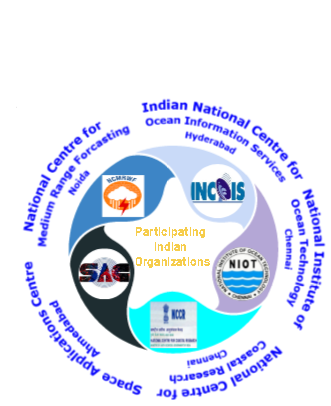
National Centre for Medium Range Forecasting, Noida
Indian National Centre for Ocean Information Services, Hyderabad
National Institute of Ocean Technology, Chennai
National Centre for Coastal Research, Chennai
Space Applications Centre, Ahmedabad
Tunga Services Pvt.Ltd. for the development of unmanned aerial systems
Societal impact
Short Term :
Field measurements/survey in the coastal regions, especially from unmanned aerial systems, will contribute directly towards the Integral Coastal Zone Management (ICZM), which is an international initiative on a dynamic, multidisciplinary and iterative process to promote sustainable management of coastal zones.
Medium Term :
Improving climate modeling and monsoon prediction in the Indian subcontinent region will influence the essential livelihood of over a billion people through its role in agriculture and water resources. In addition, improving even the short-term predictions of events like cyclones and tropical depressions are of immense value. A rigorous approach to modeling transport of scalar species like nutrients, oxygen concentration and plankton, and contaminants like microplastics, in the upper ocean can provide useful insights on biological activity, leading to invaluable information to fisheries and ecological studies. Analysis of surface waves is useful for predicting monsoon activity, identifying coastal regions prone to erosion, improve navigational planning by identifying regions with threat to boats and commercial shipping.
Long Term :
Unmanned Aerial Systems, owing to their surveillance capabilities, will be directly useful for civic bodies for mapping of water bodies and construction sites, coastguard for search and rescue operations, the armed forces and para-military for surveillance applications.
Sustenance statement :
The theme of the proposed centre is highly relevant to India’s National Monsoon Mission programme of the Ministry of Earth Sciences. The corresponding fundamental science questions are also of interest to DST. While the focus will be on the Bay of Bengal in the initial phase, expansion towards the Arabian sea and the open oceans of the Indian ocean will be natural longer-term plans. Also, since the common theme of geophysical flows is relevant for the entire ocean, the centre will seek support from other MoES labs like NCPOR, IITM, and global agencies like ONR (USA). Internal waves are relevant to the Indian Navy and DRDO in the contexts of submarine detection and acoustic propagation. ISRO labs, including SAC, NARL and NRSC, will also be interested in the research initiative for its oceanography, meteorology and image processing activities.
The establishment of UASs as oceanography and meteorology equipment will be a game-changer in several applications. Examples include weather monitoring by Indian Meteorology Department, in airports, and for missile and rocket launches. In addition, coastal zone monitoring is one of the important mandates of INCOIS and NIOT. Several other surveillance applications like monitoring of Highways, Railways & Waterways, mapping water bodies and construction sites etc. will also open up. ISRO is interested in the UASs for payload testing and calibration of satellite measurements. Finally, this RI could lead towards disruptive technologies like deployment of ocean sensors from UASs.
Technical/ Scientific Progress
FIELD MEASUREMENTS & CLIMATE MODELS
Unmanned Aerial Systems for Oceanography and Meteorology:
Quadrotor and Hexarotor The target at the end of Phase-1 was to establish quad-rotors as the platform of choice with sufficient control and stability to operate in these gusty environments. Figure 1 shows the designed quadrotor in hovering flight with the forward and downward-facing cameras installed. Along with communication with the ground control station, the cameras transmit the videos during the flight which enables visual-based flight where possible. Particularly, this capability is important close to the ground during landing and takeoff operations. The current design is based on an all-electric powertrain, i.e., batteries connected to motors and electronic speed controllers that directly drive the variable RPM propellers.

FIG. 1: In-house designed quadrotor installed with forward and downward-facing cameras.
While the quadrotor is capable of performing the given mission, further studies were done to assess the feasibility of the system in case of a motor or propeller failure. The quadrotor system does not possess sufficient redundancy and the loss of a single motor or rotor can severely compromise the mission. Therefore, a hexarotor (shown in Fig. 2) was designed and fabricated and will be the primary vehicle to perform atmospheric and sea-surface measurements over the ocean.

FIG. 2: In-house designed hexarotor for meteorological purposes currently undergoing flight tests with and without payload. Left panel: Deployable state. Middle panel: Packaged state. Right panel: Forward flight.
Table I shows a comparison of key parameters between the quadrotor and hexacopter. While the vehicle weight has increased by only a single kilogram, the addition of the two extra propellers accounts for an extra 6 kgs of overall thrust at the nominal voltage (7.4 kg at peak voltage). The available throttle for control has increased from 29% to 49%, which implies that the hexarotor possesses higher control authority — a capability required to handle the gusty environment above water bodies. Furthermore, the addition of two propellers allows for the hexarotor to operate with a motor or rotor failure.
TABLE I: Comparison of the quadrotor and hexarotor
| Parameter | Quadrotor | Hexarotor |
|---|---|---|
| Total weight, kg | 8.5 | 9.5 |
| Number of propellers | 4 | 6 |
| Motor – Propeller | Tarot 5008 340kV - 18 inches | Tarot 5008 340kV - 18 inches |
| Battery, mAh | 2×6S-16000 | 1×6S-32000 |
| Total thrust at peak voltage, kg | 14.8 | 22.2 |
| Total thrust at nominal voltage, kg | 12.0 | 18.0 |
| Thrust/Weight | 1.4 | 1.9 |
| Hover throttle (percent of maximum) | 71% | 53% |
| Available throttle (for control) | 29% | 49% |
Therefore, based on these parameters the vehicles were designed and are shown in Figs. 1 and 2 in their deployed and packaged forms. The hexrotor is currently at the final stages of flight testing at IITM campus, where successful hover, climb and forward flight tests have been conducted; as shown in Fig. 2.
The hexarotor has a current endurance of 35–40 mins with a payload capacity of around 2 kgs. The footprint of the vehicle is 1.7 m×1.7 m×0.9 m, which can be collapsed for transportation and storage. The vehicle is powered by a Pixhawk Cube with basic onboard telemetry capabilities. An onboard GPS and barometer provide the location and altitude data, which is used by the outer loop of the controller. Additionally, a LIght Detection And Ranging (LIDAR) is also instrumented that provides accurate altitude data close to the ground where error associated with the barometer makes close-to-terrain operations challenging.
Figure 3 shows the difference between the desired and achieved pitch responses during the hover phase of the tests. Note that these tests were performed with a pilot in the loop providing manual control inputs to the vehicle. Initially, the vehicle pitch is around 0 degrees indicating a hovering flight. The achieved pitch is largely in response to the pilot inputs. The pilot then provides a sudden pitch input to mimic a gust disturbance, and it can be seen that the vehicle follows this input and stabilizes soon after. Once the autopilot is fully-tuned, it is expected that the vehicle will be much more stable.
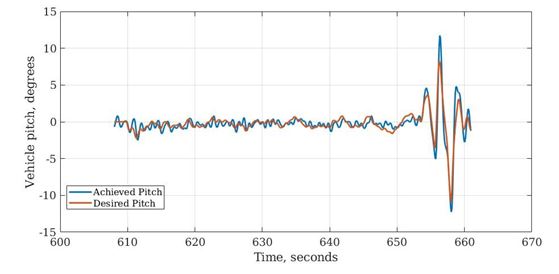
FIG. 3: Comparison of desired and achieved pitch on the hexacopter during hover testing.
Cruise Planning In the next few months, the hexacopter will be taken on a scientific cruise on-board the research vessel Sagar Manjusha 50 kms off the coast of either Chennai or Paradip (based on permissions) to make scientific measurements. To this end, contact has been established with the Ministy of Civil Aviation and permissions have been sought to perform flights up to a vertical altitude of 2 kms. In addition to the above, we have also started the design and development of a fixed-wing UAV with VTOL capability with good endurance for weather monitoring applications. The conceptual design is in progress now.
Observations of the dynamical ocean state on a continental slope in the north-west Bay of Bengal
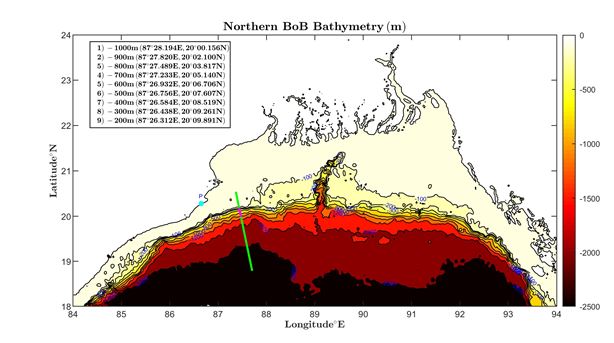
FIG. 4: A colormap of the bathymetry in the region where the measurements were performed. The green line represents the transect along which measurements were made - the extent of the transect is indicated by the small magenta line drawn on top of the green line. The legend indicates nine different locations along the transect where profiling measurements were made. Point number 1 at 87◦28.194E 20◦00.156N has a total depth of 1000 m, and the last point (number 9) at 87◦26.312E 20◦09.891N has a total depth of 200 m.
In this work, we report on an integrated set of measurements in the shelf break region off Paradip performed onboard ORV Sagar Nidhi during 3-6 October, 2019. Specifically, vertical profile measurements of conductivity-temperature-depth (CTD), currents and turbulence microstructure (small-scale shear) were made at different locations along a 20 km transect across the continental slope. Strong changes of around 8 psu in the near-surface salinity and 1 deg C in the near-surface temperature are observed during a tidal cycle at a fixed location. CTD profiles from various instruments are then visualized on the (T, S) plane, and they sometimes reveal noticeable temperature excursions at around 40 m depth, with fine-scale lateral gradients in temperature observable up to around 150 m depth. The aforementioned features are then understood in terms of advective transport by barotropic tides and geostrophic currents, which are obtained from satellite and reanalysis products. A prominent double pycnocline structure is observed in vertical stratification profiles, with a staircase-like density structure present all the way up to 250 m. With underway CTD (uCTD) measurements, lateral density gradients are also measured, using which we comment on how far the upper ocean is from geostrophic adjustment. Vertical microprofiler (VMP) measurements are then used to reveal that enhanced turbulence occurs up to around 200m depth along the transect, Correspondingly, lowered ADCP (LADCP) measurements reveal alternating current directions with depth up to 200 m. These features in the small-scale turbulence and horizontal currents are likely due to internal tide interactions with the strongly stratified upper ocean, a hypothesis motivated by internal tide ray paths and weak wind conditions. The internal tide hypothesis is then tested in high-resolution numerical experiments using a non-hydrostatic ocean model, which is run for different background stratifications observed during flood and ebb tide.
Anomalous Sea Surface Temperature Over Southeastern Arabian Sea during Indian Ocean Dipole years
The southeastern Arabian Sea is dynamically relevant due to the favorable condition it sets up for the monsoon convective cloud formation during summer monsoon, and for the genesis and intensification of cyclonic storms later during fall transition months. Here, we characterize the SST anomalies over southeastern Arabian Sea during the southwest monsoon season and fall transition months of two representative IOD years: 2016 and 2019; these years were strongly negative and positive, respectively, in terms of the IOD index. The SST fields from the group for high resolution sea surface temperature (GHRSST) reveal positive and negative anomalies during the positive and negative IOD years, respectively. In a given year, the SST undergoes two warming phases, one each during spring and fall transition months, and two cooling phases, one each during the summer and winter monsoons. The cooling rate during the summer monsoon of the negative IOD year is around 1.5 times larger than that during the positive IOD year, which subsequently results in a cooler sea surface throughout the fall transition months of the negative IOD year. We perform a heat budget analysis, using a combination of mooring, satellite and reanalysis data, to understand the various features in the SST evolution during both 2016 and 2019. The resultant net heat flux into the mixed layer favored intense cooling during summer monsoon in 2016 and favored enhanced warming during fall transition months in 2019. The shallow mixed layer depth favored penetrative loss of net shortwave radiation below the mixed layer, and thereby resulted in lower SST during the fall transition months of 2016. Lateral advection, another relevant factor for SST evolution largely favored cooling of SST during southwest monsoon of 2016 and 2019, and fall transition months of 2016. However, it has favored warming and hence favored positive anomalies in SST over southeastern Arabian Sea during fall transition months of 2019. In summary, the heat budget analyses have allowed us to identify the roles of different terms in the differing SST evolution during representative positive and negative IOD years.
Lagrangian analysis of advective transport and mixing in the northern Indian Ocean
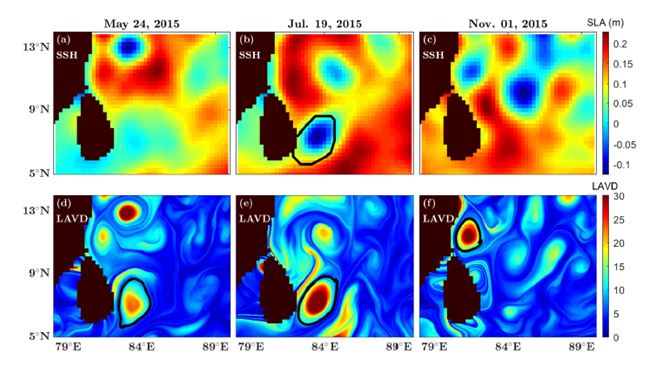
FIG. 5: The SLA (top row) and LAVD (computed with an integration time of T = 21 days, bottom row) fields on and the Sri Lanka dome eddy boundary shown in black on (a),(d) May 24, 2015, (b),(e) Jul. 19, 2015, (c),(f) Nov. 01, 2015. The black boundaries in the top and bottom rows correspond to the SLD boundary extracted by Chelton’s algorithm and LAVD-based algorithm, respectively, on the corresponding days. On May 24, 2015 and Nov 01, 2015, Chelton’s algorithm does not detect the SLD eddy.
Recent studies, based on satellite-derived ocean surface currents (Fig. 5), have indeed demonstrated the relevance of large-scale transport by ocean currents. In this line of work, we are using the framework of Lagrangian Coherent Structures (LCS) to perform systematic studies of satellite currents, ocean model outputs and laboratory experiments from the context of advective transport and mixing in the ocean. In collaboration with Eric D’Asaro at the University of Washington, Seattle, USA, the LCS analysis is also being extended to reduced gravity model outputs to understand the advective transport and mixing of various scalar species.
Seasonal variations in coastally generated near-inertial currents and associated mixing within an Arctic fjord
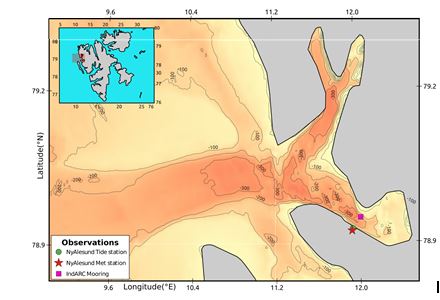
FIG. 6: Bathymetry (meters) for the region showing Kongsfjorden. Inset shows the whole Svalbard region. The magenta square at (12◦E,78.95◦N) indicates the IndARC mooring location, whereas the other two markers show the nearby meteorological and tidal measurement stations. More details of the IndARC mooring can be found in Venkatesan et al. (2016).
Hydrographic observations from IndARC mooring within the Arctic fjord, Kongsfjorden (Fig. 6) show the presence of CNIWs during strong storm events. Radiating near-inertial waves from the coast show a mode-1 structure in the filtered currents, followed by downward propagating energy. Strong shear due to the 180 degree phase change of currents is observed near the bottom of the mixed layer. The depth of such strong shear follows the seasonal changes in the mixed layer depth. It is shown that the effect of tides is minimal in the generation and propagation of CNIWs. A combination of theoretical and high-resolution numerical modeling is performed to understand the aforementioned mooring observations, and investigate wave-induced mixing. Constantly decreasing winter sea-ice in this region could result in enhanced sub-surface mixing.
PROCESS STUDIES
Instabilities in geophysical eddies
FIG. 7: (a) A schematic of the axisymmetric base flow (uB = V (r,z)eω) considered in this study. The colour indicates density, and the black curves denote streamlines. The radial spacing between neighbouring streamlines is inversely proportional to the magnitude of the local azimuthal velocity. The flow is stably stratified along z. The radial density gradient and the vertical (along z) gradient of the azimuthal velocity are in thermal wind balance. (b) Schematic showing the perturbation wave vector k and the angle θ it makes with the z-axis.
We perform a local stability analysis of an idealized model of the stratified vortices that appear in geophysical settings. The base flow comprises an axisymmetric vortex with background rotation and an out-of-plane stable stratification, and a radial stratification in the thermal wind balance with the out-of-plane momentum gradient (see Fig. 7). Solving the local stability equations along fluid particle trajectories in the base flow, the dependence of short-wavelength instabilities on the Schmidt number Sc (ratio between momentum and mass diffusivities) is studied, in the presence of curvature effects. In the diffusion-free limit, the well-known symmetric instability is recovered. In the viscous, double-diffusive regime, instability characteristics are shown to depend on three non-dimensional parameters (including Sc), and two different instabilities are identified:
- a monotonic instability (same as symmetric instability at Sc = 1), and
- an oscillatory instability (absent at Sc = 1). Separating the base flow and perturbation characteristics, two each of base flow and perturbation parameters (apart from Sc) are identified, and the entire parameter space is explored for the aforementioned instabilities. In comparison with Sc = 1, monotonic and oscillatory instabilities are shown to significantly expand the instability region in the space of base flow parameters as Sc moves away from unity. Neutral stability boundaries on the plane of Sc and a modified gradient Richardson number are then identified for both these instabilities. In the absence of curvature effects, our results are shown to be consistent with previous studies based on normal mode analysis, thus establishing that the local stability approach is well suited to capturing symmetric and double-diffusive instabilities. This work provides a better understanding of the likelihood of monotonic and oscillatory instabilities in typical oceanic settings.
Instabilities in internal gravity waves
This work has reviewed the current knowledge on instabilities in internal gravity waves, especially the growth of small-amplitude disturbances. The reviewed topics include linear internal waves and their different two-dimensional spatial forms, the general ideas concerning triadic resonance in internal waves, and instability characteristics of plane waves, wave beams and modes.
Internal wave triadic resonance in stratified shear flows
FIG. 8: Contour plot of the superharmonic contribution from the interaction of two primary IGWs (of mode numbers m and n), indicating the divergences at specific values of Richardson number (Ri) and excitation frequency (). (Source - Patibandla et al. JFM 2021)
In our recent study (Patibandla et al. JFM 2021), we have studied resonant interactions among internal gravity waves (IGWs). We show that even the presence of a small shear in the flow can lead to a large number of resonant interactions, when compared to the case of no background flow, significantly enhancing the pathways leading to dissipation. See Fig. 8.
Particle-laden flows
In the first part of our study, we have observed that the physics of shear-induced migration can lead to enhanced instability.
Axial vortices and their breakdown
We are currently working on the inverse problem to identify the nature of large planetary axial flows. ( Physics of Fluids 33, 107111 (2021); Physics of Fluids 33, 064105 (2021); Phys. Rev. Fluids 5, 113504, 2020)
Two-point correlations in scale-space in turbulence
Currently, we are evaluating the heat transfer across scales using several data sets, including flows in the atmosphere and oceans.
Numerical simulation of wave-impact with entrapped air on offshore structures
A 3D computer code with a six-equation compressible multifluid formulation is developed and validated for oscillating water columns and is being applied for the wave impact phenomena described in (Proc. Royal Soc. A 470, 20140542 (2014)).
Journal articles
Dheeraj Varma, Manikandan Mathur and Thierry Dauxois, ”Instabilities in internal gravity waves”, Mathematics in Engineering, in press (2022).
Ramana Patibandla, Manikandan Mathur and Anubhab Roy, ”Triadic resonances in internal wave modes with background shear”, J. Fluid Mech., 929, A10-1-25 (2021).
Suraj Singh and Manikandan Mathur, ”Diffusive effects in local instabilities of a baroclinic axisymmetric vortex”, J. Fluid Mech., 928, A14-1-32 (2021).
Emily Shroyer, Amit Tandon, Debasis Sengupta, Harindra JS Fernando, Andrew J Lucas, J Thomas Farrar, Rajib Chattopadhyay, Simon de Szoeke, Maria Flatau, Adam Rydbeck, Hemantha Wijesekera, Michael McPhaden, Hyodae Seo, Aneesh Subramanian, R Venkatesan, Jossia Joseph, S Ramsundaram, Arnold L Gordon, Shannon M Bohman, Jaynise Prez, Iury T Simoes-Sousa, Steven R Jayne, Robert E Todd, GS Bhat, Matthias Lankhorst, Tamara Schlosser, Katherine Adams, SUP Jinadasa, Manikandan Mathur, M Mohapatra, E Pattabhi Rama Rao, AK Sahai, Rashmi Sharma, Craig Lee, Luc Rainville, Deepak Cherian, Kerstin Cullen, Luca R Centurioni, Verena Hormann, Jennifer MacKinnon, Uwe Send, Arachaporn Anutaliya, Amy Waterhouse, Garrett S Black, Jeremy A Dehart, Kaitlyn M Woods, Edward Creegan, Gad Levy, Lakshmi H Kantha, Bulusu Subrahmanyam, ”Bay of Bengal Intraseasonal Oscillations and the 2018 Monsoon Onset”, Bulletin of the American Meteorological Society, May 21, 1-44 (2021).
R. Vishnu, Manjul Sharma and A. Sameen, ”Effect of heating on topology of vortex breakdown in Vogel-Escudier flow”, Physics of Fluids, 33, 107111 (2021).
Manjul Sharma and A. Sameen, ”Synopsis of Vogel-Escudier flow”, Physics of Fluids, 33, 064105 (2021).
Darish Jeswin Dhas S and Anubhab Roy, Wavy regime of a colloidal falling film, J. Fluid Mech., under review (2022).
Darish Jeswin Dhas S and Anubhab Roy, Stability of gravity-driven particle-laden flows - Roles of shear-induced migration and normal stresses J. Fluid Mech., under review (2022).
H.M. Aravind, Thomas Dubos and Manikandan Mathur, ”Local stability analysis of homogeneous and stratified Kelvin-Helmholtz vortices”, J. Fluid Mech., under review (2022).
Anubhab Roy, Piyush Garg, Shashikiran Jhumpal Reddy, Ganesh Subramanian, ”Inertio-elastic instability of a vortex column”, J. Fluid Mech., under review (2022).
Conferences
Jai Kumar, Ravi Kamal Choudhary, Manikandan Mathur, Neeraj Agarwal, and Rashmi Sharma, “A study of mixing and biological activity in the Arabian sea using Finite Size Lyapunov exponents”, Seventh National Conference of the Ocean Society of India (OSICON-21) organized by National Centre for Polar and Ocean Research, Goa, India (August 12 - 14, 2021).
Dheeraj Varma, Vamsi K Chalamalla and Manikandan Mathur, ”Superharmonic excitation by selfinteraction of internal waves in nonuniform stratifications”, The 25th International Congress of Theoretical and Applied Mechanics (ICTAM 2020+1) (22 to 27 August, 2021).
Manikandan Mathur and Suraj Singh, “Diffusive and curvature effects on symmetric instability in stratified vortices”, Dynamics Days Europe, Nice, France (August 23-27, 2021).
Suraj Singh and Manikandan Mathur, “Double-diffusive effects in the local instabilities of an elliptical vortex”, Dynamics Days Europe, Nice, France (August 23-27, 2021).
Jithendra Raju Nadimpalli and Manikandan Mathur, ”Seasonal variations in coastally generated near-inertial currents and associated mixing within an Arctic fjord”, Ocean Sciences Meeting, USA (Feb. 24 - March 4, 2022). vi. Patibandla Ramana, Manikandan Mathur and Anubhab Roy, ”Triadic resonances in the internal wave modes with background shear”, Ocean Sciences Meeting, USA (Feb. 24 - March 4, 2022).
Darish Jeswin Dhas and Anubhab Roy, ”Instabilities in sediment-laden free surface flows”, Ocean Sciences Meeting, USA (Feb. 24 - March 4, 2022).
Himanshu Mishra, Patibandla Ramana and Anubhab Roy, ”Transport of anisotropic particles in surface and internal gravity wave fields”, Ocean Sciences Meeting, USA (Feb. 24 - March 4, 2022).
N. Jithendra Raju, J. Lijin, N. Suresh Kumar, V.P. Thangaprakash, B. Praveen Kumar and Manikandan Mathur, ”Observations of the dynamical ocean state on a continental slope in the north-west Bay of Bengal”, International Indian Ocean Science Conference (IIOSC - 2022), Goa, India (14-18 March, 2022).
Simi Mathew and Manikandan Mathur, ”Anomalous Sea Surface Temperature Over Southeastern Arabian Sea during Indian Ocean Dipole years”, International Indian Ocean Science Conference (IIOSC - 2022), Goa, India (14-18 March, 2022).
Infrastructure
The quadrotor and hexarotor platforms for making vertical profile measurements of the atmosphere are ready.
Meetings
First Meeting of the Geophysical Flows Lab
An international meeting (online) was held on September 7, 8 and 13, 2021 to discuss the objectives and proposed activities under the research initiative Geophysical Flows Lab. All the investigators (and their research groups) at IIT Madras, the national and the international collaborators at GFL participated in this meeting. Two days of short talks by all the participants was followed by the last day of panel discussions. Based on the meeting, a document detailing the research focus of the RI during the first few years was prepared.
IRIS Webinar
This webinar was organized by IIT Madras on September 28, 2021 to present an overview of the research initiative to a wider audience, including young and prospective researchers from across India. Following an introduction to the Research Initiative by Manikandan Mathur, a panel discussion along with questions from the audience was led by Eric D’Asaro. The recording of this webinar can be found here.
Discussion Meeting on Waves, Instabilities and Mixing in Rotating and Stratified Flows
The team of Anubhab Roy, Manikandan Mathur, Philippe Odier, Sylvain Joubaud and Thierry Dauxois organized the ICTS meeting (online) during April 4-8, 2022. More details of the meeting can be found here. The entire list of talks and the links to the recordings can be found in this pdf.
Second Meeting of the Geophysical Flows Lab
This in-person meeting is proposed to be held in August 2022 at IIT Madras. Please watch this space for more updates.
Talks
Manikandan Mathur will be an invited speaker at the ICERM meeting on Prediction and Variability of Air-Sea Interactions: the South Asian Monsoon during June 13-15, 2022.
Anubhab Roy will give a seminar at NORDITA, Sweden on May 16, 2022, and a colloquium at ENS de Lyon, France on May 23, 2022.
Anubhab Roy will be giving a talk at the workshop on Two-Phase Modelling for Sediment Dynamics at the Les Houches school of Physics during June 5-10, 2022.
Anubhab Roy will be giving a talk at IMA10 - the 10th conference of the International Marangoni Association.
a postdoc at GFL has given the following talks:
Raju, N.J., and Mathur M. Coastally generated near-inertial currents in an Arctic fjord, Kongsfjorden. Gordon Research Conference on ocean mixing, MA, USA, June, 2022.
Raju, N.J., Lijin J., Suresh Kumar N., Thangaprakash V. P., Praveen Kumar B., and Mathur M. Observations of the dynamical ocean state on a continental slope in the north-west Bay of Bengal. IIOSC, Goa, India, March, 2022.
Raju, N.J., and Mathur M. Seasonal variations in coastally generated near-inertial currents and associated mixing within an Arctic fjord. Ocean Science Meeting, Hawaii, USA, February, 2022. Simi Mathew (postdoc at GFL) presented a talk on Anomalous Sea Surface Temperature Over Southeastern Arabian Sea with the changing phase of Indian Ocean Dipole at the International Indian Ocean Science Conference, 14-18, March, 2022.
Suraj Singh (graduated PhD student from GFL) and Manikandan Mathur delivered the following two invited talks at Dynamics Days Europe 2021 - Nice, France:
Diffusive Effects on symmetric instability in stratified vortices, Suraj Singh, Manikandan Mathur
Double-diffusive effects in the local instabilities of an elliptical vortex. Suraj Singh, Manikandan Mathur.
Dheeraj Varma (PhD graduate from IIT Madras, currently a postdoc at ENS de Lyon) has given a couple of talks on work done at GFL:
Superharmonic excitation by self-interaction of internal waves in nonuniform stratifications, Dheeraj Varma, Vamsi K Chalamalla & Manikandan Mathur,The 25th International Congress of Theoretical and Applied Mechanics ICTAM 2020+1, 22 to 27 August, 2021.
Weak nonuniformity in stratification triggers new triadic resonances in internal wave modes, Dheeraj Varma, Thierry Dauxois and Manikandan Mathur, Waves, Instabilities and Mixing in Rotating and Stratified Flows, 4th to 8th April, 2022.
At Geophysical Flows Lab, we run a seminar series. While the average frequency is around once a month, we are happy to host visitors for a seminar more frequently. The recordings of previous talks will be made available soon.
Mobility
Outbound
Manikandan Mathur is visiting Laboratoire de Physique at the Ecole Normale Superieure de Lyon, France during May 28, 2022 to April 25, 2022. During this visiting professorship, he will work with Thierry Dauxois, his research group and colleagues on various aspects of internal gravity waves. During this visit, he is also working with Louis Gostiaux and Andrea Maffioli at Ecole Centrale de Lyon on stratified flows and mixing.
Manikandan Mathur (PI) will be visiting the US in the second half of 2022, with potential activities including:
- research visit to the groups of some of the international collaborators of GFL,
- participation in the ICERM meeting on ”Prediction and Variability of Air-Sea Interactions: the South Asian Monsoon” at Brown University and
- presentation and participation in the American Physical Society Division of Fluid Dynamics annual conference.
Anubhab Roy is visiting the Laboratoire de Physique at ENS de Lyon, France from May 2, 2022 to June 17, 2022 to work on collaborative research in geophysical flows. Specifically, he will be interacting with the research group of Thierry Dauxois on a range of topics on stratified shear flows. This research visit is also a part of a SPARC project between IIT Madras and ENS de Lyon, and is supported by the Prakash Faculty Externship (instituted by the class of 1978). During this visit, Anubhab Roy will also give seminars at NORDITA, Stockholm, Sweden, Les Houches and Romania. He will also be working with the research groups of Sylvain Joubaud and Philippe Odier on resonant interactions in internal waves.
Anubhab Roy (co-PI) will be visiting the US in the second half of 2022, with potential activities including:
- research visit to the group of Mohamed Houssem Kasbaoui at Arizona State University
- participation in the Geophysical Fluid Dynamics program of the Woodshole Oceanographic Institution, and
- presentation and participation in the American Physical Society Division of Fluid Dynamics annual conference.
A. Sameen (co-PI) will be presenting and participating in the 14th European Fluid Mechanics Conference at Athens, Greece during 13-16 September 2022.
Suraj Singh (recently graduated PhD student from the group of Manikandan Mathur) has joined Amit Tandon at the University of Massachusetts at Dartmouth as a postdoc in April 2022.
J. Lijin will visit the research groups of Eric D’Asaro at the University of Washington, Seattle, USA and Sutanu Sarkar at the University of California at San Diego, USA during August - September 2022 to work on some parts of his PhD thesis on stratified wakes.
Jithendra Raju Nadimpalli, a postdoc at GFL, is visiting the US from May 2, 2022 to July 2, 2022 for collaborative research with two different labs. During the first part of his visit, he will work with the group of Aneesh Subramanian at the University of Colorado Boulder on coupled modeling for climate research. In the latter part of his visit, he will work with the research group and colleagues of Jonathan Nash at the Oregon State University on internal wave observations and modeling.
Patibandla B.L.V. Ramana, a PhD student in the Geophysical Flows Lab, will visit the Laboratoire de Physique at ENS de Lyon, France from May 23, 2022 to August 23, 2022 to work on collaborative research in internal waves. This research visit is also a part of a SPARC project between IIT Madras and ENS de Lyon. Patibandla Ramana will work with the research group of Sylvain Joubaud, Philippe Odier and Thierry Dauxois on resonant interactions in internal waves.
Darish Jeswin Dhas (current PhD student with Anubhab Roy) will be visiting Arizona State University to work with the research group of Mohamed Houssem Kasbaoui on particle-laden geophysical flows.
Inbound
Eric D’Asaro (Applied Physics Laboratory, University of Washington at Seattle, USA) will visit IIT Madras in the second half of 2022 to work with Manikandan Mathur and his group, and interact with all the members of GFL.
Amit Tandon (University of Massachusetts at Dartmouth, USA) will visit IIT Madras in the second half of 2022 to work with Manikandan Mathur and his group, and interact with all the members of GFL.
Thierry Dauxois (ENS de Lyon, France) will visit IIT Madras in the second half of 2022 to work with Manikandan Mathur, Anubhab Roy and their groups, and interact with all the members of GFL.
Mohamed Houssem Kasbaoui(Arizona State University, USA) will visit IIT Madras in the second half of 2022 to work with Anubhab Roy and his group, and interact with all the members of GFL.
Relationship
Industrial engagement
Bharat Electronics Limited - A formal MoU has been signed between IIT Madras and BEL, and the proposed activities under the MoU involve the development of unmanned aerial systems for various applications.
National Institute of Ocean Technology (NIOT), Chennai, India.
Indian National Centre for Ocean Information Services (INCOIS) - A formal MoU has been signed between IIT Madras and INCOIS to collaborate on ocean-going field measurements.
National Centre for Medium Range Weather Forecasting (NCMRWF), Noida, India.
Space Applications Centre, ISRO, Ahmedabad, India.
Indian Navy - The engagement with the Indian Navy, particularly related to field operations of unmanned aerial systems, has significantly developed with the appointment of Rear Admiral George as a Professor of Practice in the Department of Aerospace Engineering, IIT Madras.
University engagement
Thierry Dauxois (ENS de Lyon) - The university is hosting Manikandan Mathur, Anubhab Roy and a PhD student currently (summer 2022) for research collaborations.
Amit Tandon (University of Massachusetts at Dartmouth, USA) - An MoU agreement between IIT Madras and the university has been signed to facilitate collaborative research with joint research (PhD) students. Amit Tandon will be visiting IIT Madras for research collaborations in 2022.
Eric D’Asaro (Applied Physics Laboratory, University of Washington at Seattle, USA) is set to visit IIT Madras for research collaborations in 2022 to work on a range of topics under GFL, with a specific focus on the role of three-dimensional processes in the Bay of Bengal.
Manikandan Mathur works with multiple groups - Jennifer MacKinnon, Sutanu Sarkar and Andrew Lucas (University of California at San Diego, USA), Jonathan Nash and Simon de Szoeke (Oregon State University, USA), Emily Shroyer (Office of Naval Research, USA), Tom Farrar and Amala Mahadevan (Woodshole Oceanographic Institute, USA) - on an overall survey of the role of three-dimensional processes in the Bay of Bengal.
GFL investigators are working with Aneesh Subramanian (University of Colorado at Boulder, USA) on climate modeling in the northern Indian ocean.
Mohamed Houssem Kasbaoui (Arizona State University) - We have been actively collaborating with Prof. Kasbaoui on instabilities in dusty vortices. An isolated vortex is a modally stable flow structure. Using a combination of Euler-Lagrange simulations and linear stability analysis we have shown that the presence of inertial dispersed
Updates
News
Preparations for drone operations in the upcoming research cruise are underway
On March 5, 2022, the team of Bharath Govindarajan, H.S.N. Murthy and Manikandan Mathur visited the Ministry of Earth Sciences Coastal Research Vessel Sagar Anveshika at the Chennai port to perform a feasibility study of UAV operations aboard the vessel. On April 27th, 2022, the team of Bharath Govindarajan, Manikandan Mathur, Pavan N. and Achu Shankar visited the Ministry of Earth Sciences Coastal Research Vessel Sagar Tara at the Chennai port to conduct UAV trials. Thanks to the National Institute of Ocean Technology to facilitate these visits, which are in preparation for the upcoming research cruise in the Bay of Bengal.
Two new sponsored projects have been approved:
- A project titled ”IC Engine Driven Quadrotor Biplane Tailsitter” has been approved under the Device Development Programme of DST. The project investigators are P.A. Ramakrishna, Bharath Govindarajan, and Joel George (all co-PIs of GFL).
- SERB-MATRICS project titled “Explosive resonant interactions with singular eigenfunctions” (2022-2025), with Anubhab Roy as the PI.
Research proposals to
- Prime Minister’s Office (thematic area “Monsoon, climate and weather” as part of the Science and Technology Clusters),
- SUPRA scheme of DST,
- Ministry of Earth Sciences for Arabian Sea observations program, (iv) National Physical Oceanography Laboratory (NPOL), DRDO, Cochin, India are under review.
Congratulations to Suraj Singh on defending his PhD thesis titled Diffusive effects in local instabilities of stratified vortices on October 22, 2021. He is now a postdoc in the group of Amit Tandon at the University of Massachusetts at Dartmouth, USA.
We are happy to announce the signing of a Memorandum of Understanding between IIT Madras and the Indian National Centre for Ocean Information Services on January 21, 2022. Under the MoU, IIT Madras and INCOIS will cooperate in the field of Ocean Observations and Technology and also engage in collaborative research and development of GFL.
Starting August 2022, Anubhab Roy and Manikandan Mathur are introducing an elective course titled Geophysical Fluid Dynamics, targeted towards senior undergraduate students, Masters students and research scholars with a background in Fluid Mechanics.


